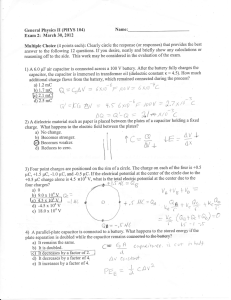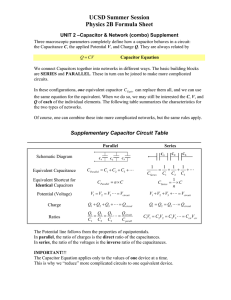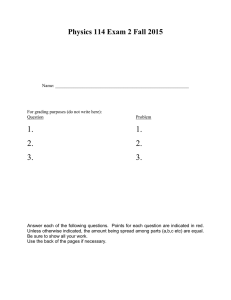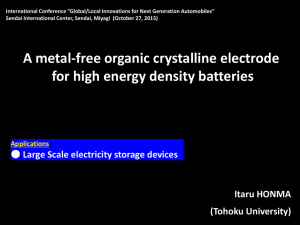Homework, Chapter 2
advertisement
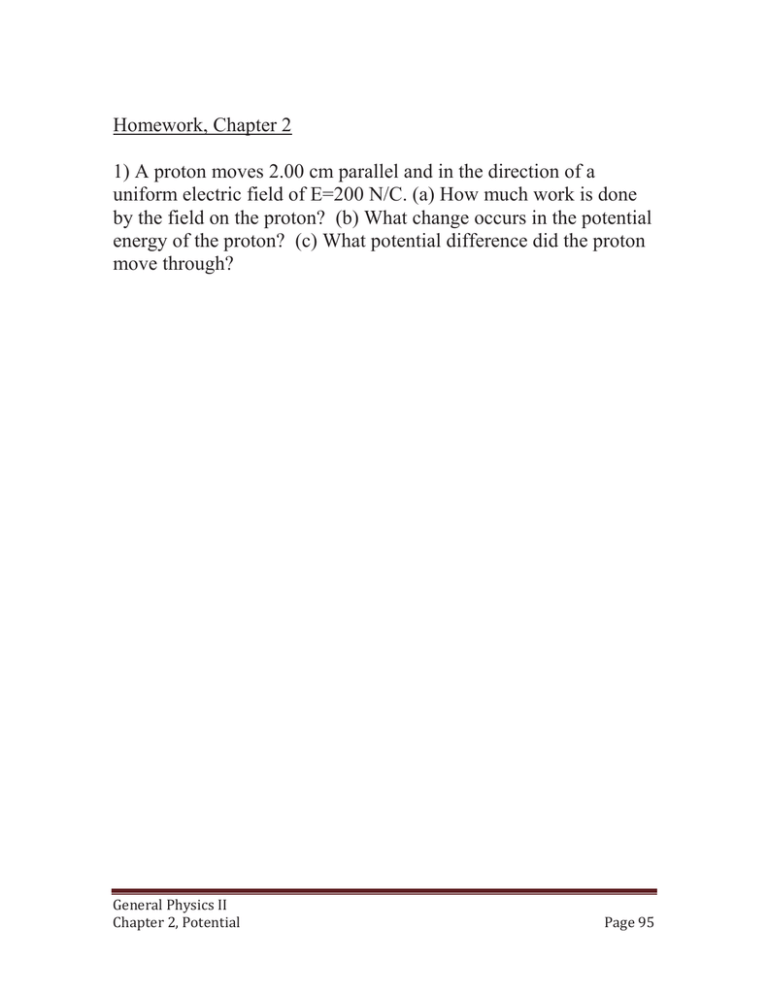
Homework, Chapter 2 1) A proton moves 2.00 cm parallel and in the direction of a uniform electric field of E=200 N/C. (a) How much work is done by the field on the proton? (b) What change occurs in the potential energy of the proton? (c) What potential difference did the proton move through? General Physics II Chapter 2, Potential Page 95 2) A charged particle accelerated through a potential difference of 60.0 V has its potential energy decreased by 2.42´10-17 J. Calculate the charge on the particle. Is the charge positive or negative? General Physics II Chapter 2, Potential Page 96 3) (a) Find the electric potential 1.00 cm from a proton. (b) What is the electric potential difference between two points that are 1.00 cm and 2.00 cm from a proton? General Physics II Chapter 2, Potential Page 97 4) a) Find the electric potential, taking zero at infinity, at the upper right corner (the corner without a charge) of the rectangle in this figure. (b) Repeat if the 2.00-μC charge is replaced with a charge of -2.00 μC. General Physics II Chapter 2, Potential Page 98 5) Three charges are situated at corners of a rectangle as in this figure. How much energy is required to assemble these charges, assuming they come from a very far distance away? General Physics II Chapter 2, Potential Page 99 6) The electric potential in a region of space is given by V = 2xy 3zx + 5y2, with V in volts and the coordinates in meters. If point P is at x = 1 m, y = 1 m, z = 1 m, find (a) the potential at P and (b) the x, y, and z components of the electric field at P. General Physics II Chapter 2, Potential Page 100 7) A 60.0´10-15 F capacitor has a plate area of 21.0 X 10-12 m2. Determine the plate separation of such a capacitor. (Assume a parallel-plate configuration). The diameter of an atom is on the order of 10-10m = 1 angstrom. How many atoms will fit between the parallel plates of this capacitor. General Physics II Chapter 2, Potential Page 101 8) A series circuit consists of a 0.050-μF capacitor, a 0.100-μF capacitor, and a 400-V battery. Find the charge (a) on each of the capacitors and (b) on each of the capacitors if they are reconnected in parallel across the battery. General Physics II Chapter 2, Potential Page 102 9) In this figure a 10 V battery is connected across capacitors of capacitances C1=2μF, C2=4μF, C3=2μF, C4=12μF, C5=8μF, and C6=8μF. What is the equivalent capacitance and the voltage and charge for each capacitor? General Physics II Chapter 2, Potential Page 103 10) (a) Find the equivalent capacitance of the capacitors in this figure. (b) Find the charge on each capacitor and the potential difference across it. General Physics II Chapter 2, Potential Page 104 11) Express the potential due to this charged bar at P in terms of L, d, and l. General Physics II Chapter 2, Potential Page 105 General Physics II Chapter 2, Potential Page 106
